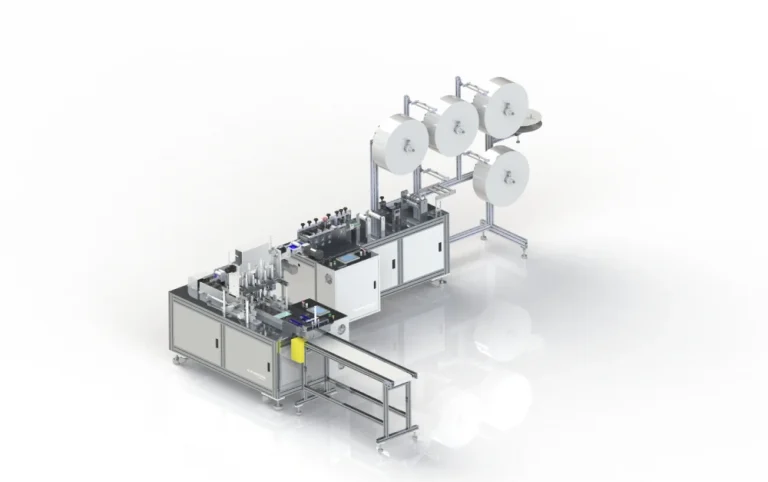Maskmaker S80
The Maskmaker S80 is a fully automatic machine, developed in Brazil to meet the high demand for manufacturing surgical masks. Every detail of the equipment was designed with a view to providing durability, process stability and compliance with the standards required by Anvisa. It uses ultrasonic welding technology, which allows the simultaneous welding of several layers of TNT with great resistance, in addition to providing a superior finish to any other welding or sewing technology. As it is national, it can be acquired through subsidized government lines such as Finame, in up to 10 years, with a grace period and low interest rates.
SPECIFICATIONS
INCLUDED ITEMS
EQUIPMENT GENERAL DATA
| Technology | ultrasound |
| powers | 2 ultrasound units 2600W with 20KHz and 1 ultrasound unit 1500W with 20KHz |
| mask model | 3 to 4 layer surgical mask with ultrasonic welding |
| Performance | Up to 60 masks per minute |
- Feed module with 3 to 4 TNT roller supports with sensors;
- Mask shaping module with pleating, nose clip insertion and cutting, logo engraving and cutting;
- Transport module for transferring the forming module to the elastic welding module;
- Automatic elastic insertion module, with elastic feeding, cut to size, simultaneous 4-point welding;
- Mask delivery and stacking module with finished piece count.
- Software for simultaneous operation of all modules with management of the entire sensing system of the equipment;
- Prepared for Industry 4.0 integrations
- Maximum diameter of non-woven rolls: 600 mm
- Maximum width of non-woven rolls: 200 mm
- Number of TNT rolls: up to 4 units
- TNT roll core internal diameter: 60 to 80 mm
- Maximum dimensions of the Wire Roll (Nose Clip): width (120 mm) and diameter (500 mm)
- Wire Dimensions: 1.5mm to 4mm shank
- Minimum wire roll inner diameter: 35 mm
- Number of rolls Nose Clip Wire: 1 unit
FREQUENTLY ASKED QUESTIONS
THE MAIN QUESTIONS
- Maskmaker S80 manufactures surgical masks within the strict rules of Anvisa;
- Its ultrasonic welding power is 2,600W and 1,500W, (Chinese machines normally operate with 1,000W);< /li>
- Its high power delivers a weld that resists the traction specified in the most diverse standards with safety and stability, that is, the elastics do not loosen;< /span>
- Comes with integrated and synchronized mask body making and elastic insertion modules, which is an advantage over competing solutions that are semi-automatic ;
- Its manufacturing flow is constant and stable, with a speed capable of manufacturing up to 60 masks per minute, with very little or no loss;
- Deliver great mask manufacturing stability, no product waste and a rework rate 2 to 3 times lower than competing machines;
- Allows insertion of logo for manufacturing custom masks;
- Equipped with electronic devices that allow connection to software and IOT systems for remote operation monitoring – Industry 4.0;
- The machine truly complies with Brazilian safety standards NR12 with electrical and mechanical protections for operator safety.
Ultrasonic welding is a welding process that uses high-frequency sound waves to join two or more materials together. The technique consists of applying a specific frequency of sound waves (generally between 20 kHz and 50 kHz) to the materials to be welded. These sound waves create mechanical vibrations that cause friction and heat at the point of contact of the materials, which leads to the melting and welding of the materials.
Ultrasonic welding is widely used to weld thin and delicate materials such as plastics, fabrics and non-ferrous metals. Furthermore, the technique is known to be accurate, fast and efficient, and not to cause damage to surrounding materials. Ultrasonic welding is also widely used to produce electronic components, medical devices, clothing and other products.
Ultrasonic welding and heat welding are two different techniques used in the manufacture of surgical masks. The advantages of ultrasonic welding over heat welding are:
- Precision: Ultrasonic welding is capable of welding fabrics with high precision without causing damage to surrounding tissues. Heat welding, on the other hand, can cause damage to these fabrics such as shrinkage, deformation or burning. This can affect the accuracy and safety of surgical masks.
- Versatility: Ultrasonic welding can be used to weld a variety of fabrics, including fine and delicate fabrics, which is important for the production of surgical masks, whereas in heat welding, there may be damage to the materials, compromising the mask manufacturing process.
- Process hygiene: while ultrasonic welding does not promote contamination in fabrics, heat welding can cause contamination with particles in the air, and compromise the quality and safety of surgical masks.
- Low cost: Ultrasonic welding requires little maintenance and has a long service life, which can result in low operating costs, while heat requires more maintenance due to the heat generated in the system.
Because it is manufactured in Brazil, you can buy it in installments of up to 10 years, with up to a 2-year grace period through lines subsidized by the government such as: Proger, BNDES Finame, BNDES Card. But it is also possible to acquire by leasing-type financing; financing for cash flow and working capital. These lines can finance most or all of your equipment. Our team of experts will inform you of every available alternative.
 CHOOSE THE LANGUAGE
CHOOSE THE LANGUAGE 






